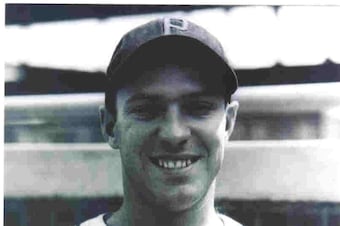

Left fielder and baseball innovator Danny Litwhiler was one of the lone standouts on an otherwise offensively inept 1941 Phillies squad.
This is the third entry in the countdown of the five worst teams in Phillies history. For the introduction and criteria used for this series, please check out the first entry here.
Team: 1941 Phillies
Record: 43-111 (T-4th least wins in any season, T-2nd least wins in seasons with 140 games played or more)
Winning Percentage: 30.1% (3rd worst winning percentage in any season, 2nd worst winning percentage in seasons with 140 games played or more)
Run Differential: Minus 292
The 1941 Phillies line up was young, promising, and full of potential. The youth was there: with an average age of 26.25 years old in their most common starting line-up, the team started a pair of 23-year olds up the middle with Danny Murtaugh at second and Bobby Bragan at short. The promise was there: left fielder Danny Litwhiler was 24-years old and hit .305/.350/.466 with 18 homers leading the team in hits, doubles, triples, homers, and slugging. And the potential was becoming a reality: 27-year old first baseman Nick Etten would lead the team with a .311 average, a .405 OBP, and 79 RBIs.
Sadly, Lithwhiler and Etten would be the lone bright spots in a line-up that would hit just .244, finishing dead-last out of 16 Major League teams in runs scored, batting average, on-base percentage, slugging, and any combination of therefor. Late-blooming, 30-year old third baseman Pinky May continued to play solid defense and was a solid offensive contributor the previous season but saw a 30 or so point drop across his slash line while similarly late-blooming catcher Bernie Warren hit .214 but slugged nine homers.
Murtaugh and Bragan, along with right fielder Stan Benjamin, all were among the worst regular starters in the Majors. Returning hero Chuck Klein was in the second of five years of his third stint with the team, hitting just .123 with one homer. The Phillies retro-actively ranked lasted in Total Zone defensive measures in the National League while trotting out one of the league’s worst defenses.
The ’41 squad had a solid pitching squad in comparison to our previous two entries on the list, which speaks volumes about just how bad this offense was. 21-year old Johnny Podgajny lead the squad with 181.1 IP, nine wins, 24 starts, and eight complete games while posting a 4.62 ERA. 24-year old Ike Pearson led the team in ERA at 3.57 finishing 30 out of the 46 games in which he appeared. There wasn’t anyone outright horrible among the pitching stable but Cy Blanton (no relation) went 6-13 with a 4.51 ERA and Si Johnson went 5-12 with a 4.52 ERA. Despite leading the starting pitchers with a 3.97 ERA, Lee Grissom posted a 3-12 record. The ’41 Phils ranked 14th out of 16 in the Majors in ERA and 13th in FIP, both times finishing last in the National League.
Much like the Phillies teams of years later, the Phillies traded their emerging stars just a bit too soon. Etten was traded to the Yankees following the 1942 season and won a World Series ring with them in 1943, becoming an All-Star, while leading the AL in homers in 1944. Lithwhiler received MVP votes in ’41 and would become an All-Star in 1942 before being traded midway through the 1943 season to the Cardinals. Lithwhiler and Etten would cross paths in the 1943 World Series, coming up on the short end of the stick before winning a World Series ring of his own in 1944. Lithwhile would serve his country for the 1945 season but returned and hit .277/.361/.448 in six post-war seasons.
Similarity to 2015 Phillies: The similarities are there but not as much as the ’61 or ’45 Phillies. This is the team the 2015 could have been had Cesar Hernandez and Freddy Galvis fell flat on their face and Maikel Franco been not as productive out of the gate, almost like a Ghost of Christmas Past. The other similarities are there: younger line-up with veterans on their way out with one of the most-feared sluggers of six to seven years prior winding down his career and a pitching staff full of young starters with limited upside mixed with veteran journeyman.
(Author’s note: Lithwhiler was a notable baseball figure well beyond his time in the Major Leagues. Lithwhiler became a coach, scout, author of baseball instructional books, and more living a 95-year life full of teaching and baseball. Lithwhiler has a number of notable achievements that are relatively unknown to most baseball fans: he is credited for being the first to use a state trooper’s radar gun while coaching at Florida State University, invented diamond dry, and inventing a bunting training bat. Lithwhiler released a great memoir before passing with a foreward by Stan Musial that is difficult to find but is worth the hunt and the money.)